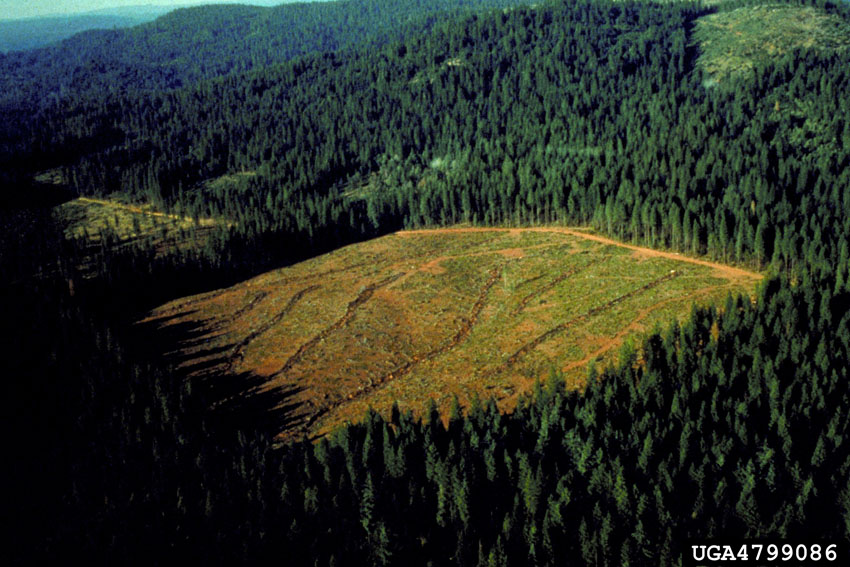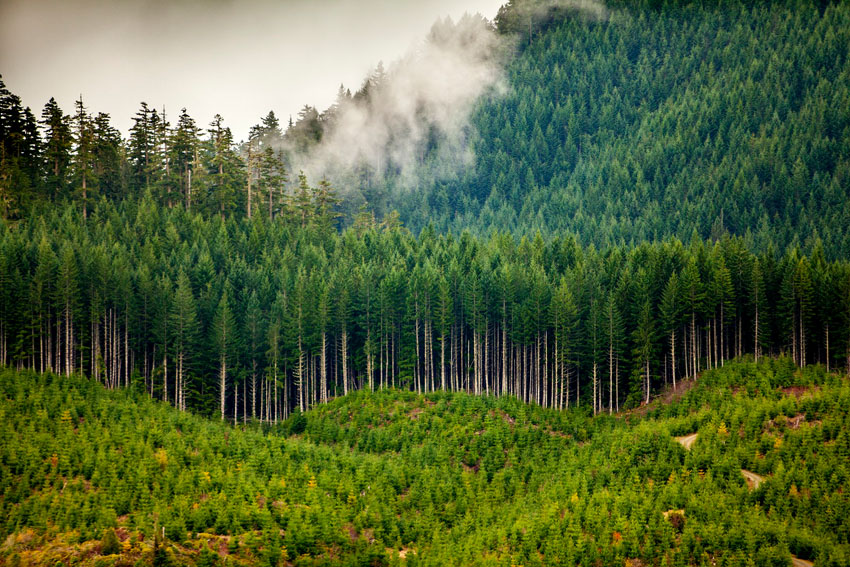The Impact of Wood Use on North American Forests
Protecting Soil and Water Quality
Soil is made up of a complex mixture of minerals, organic matter, gases, liquids, and microorganisms. It is an obvious and essential component of forest ecosystems, providing both a base for trees, plants, and organisms, and the minerals and nutrients needed for their growth. In a forest, soil is held together by the root structures of trees and plants, and protected from erosion by tree trunks, forest floor vegetation, and woody and leafy debris.
In forestry (as in agriculture), soil is the base resource; the medium that supports the ecosystem. It is therefore essential that soil be protected from damage and erosion.
For example, to avoid compacting sensitive soil, foresters may use heavy equipment in the winter when the ground is frozen instead of summer when it is soft, or use cable logging techniques instead of ground-based equipment.
Protecting against erosion is necessary, not only for the forest but also to keep soil from entering water bodies where it could be detrimental to fish habitat. Strategies involve avoiding sensitive areas (such as unstable slopes) and road construction techniques that include seeding the road with grass, creating diversion ditches, and adding water bars (diagonal channels that prevent water from flowing down the length of the road).
Conserving Biodiversity
Biological diversity, or biodiversity, refers to the variety of species and ecosystems on earth and their ecological systems. An important indicator of forest sustainability, it enables organisms and ecosystems to respond to and adapt to environmental change.
Conserving biodiversity is an essential part of forest sustainability and involves strategies at different scales.
At the landscape level, networks of parks and protected areas conserve a range of biologically and ecologically diverse ecosystems. Tens of millions of acres of North America’s forests are protected within wilderness areas and parks and through regional and local programs. Forests with special ecological attributes are also protected by established conservation easements developed through the work of local land trusts.17
From a forest management perspective, conserving biodiversity involves strategies that create a diversity of ecosystem conditions through space and time to provide diverse habitat for native species of plants and animals across the landscape. Among other things, this may include selecting harvest, renewal and tending treatments that maintain existing tree species diversity, maintaining mapped areas of standing trees within a harvested site, or planning harvest patterns based on wildlife habitat management objectives.

Photo courtesy of Oregon Forest Resources Institute
There are different age classes across the forest landscape.
“Wood products are manufactured from renewable raw material; they are reusable and biodegradable, and they continue to store carbon throughout their lifetime. These characteristics make wood an excellent alternative to many of the materials that are now widely used in construction and consumer goods, which leave a much larger ‘carbon footprint’ and include concrete, steel, aluminum, and plastic. Increasing production and consumption of wood products will therefore be part of a sustainable future.” —State of the World’s Forests 2012, FAO

Photo courtesy of Philip McDonald, USDA Forest Service
This forest in the northern Sierra Nevada mountains was clearcut to support the natural regeneration of ponderosa pine, Douglas fir, sugar pine, California white fir, and incense cedar.
Challenging Preconceptions
This course has touched on a variety of criteria for forest sustainability. Another is public discourse. Frank discussion regarding the status of North American forests, how they are managed, and the challenges they face is necessary to maintaining the many values they provide. In that spirit, this section addresses some of the most common concerns about forests and the forest industry.
True or false: Leaving the forest alone has the greatest climate change benefit. False. There is growing awareness among building designers that using wood can reduce a building’s carbon footprint, provided it comes from a sustainably managed forest. At the core of wood’s carbon benefit is the fact that as trees grow they absorb carbon dioxide (CO2) from the atmosphere, release the oxygen (O2), and incorporate the carbon into their wood, leaves or needles, roots, and surrounding soil.
Young, vigorously growing trees take up carbon quickly, with the rate slowing as they reach maturity (typically 60–100 years, depending on species and environmental factors).
Over time, one of three things happens:
- When the trees get older, they start to decay and slowly release the stored carbon.
- The forest succumbs to wildfire, insects, or disease and releases the carbon quickly.
- The trees are harvested and manufactured into products, which continue to store much of the carbon. (Wood material is approximately 50 percent carbon by dry weight.) In the case of wood buildings, the carbon is kept out of the atmosphere for the lifetime of the structure—or longer if the wood is reclaimed at the end of the building’s service life and either re-used or remanufactured into other products.
Unless the area is converted to another use, the cycle begins again as the forest regenerates and young seedlings once again begin absorbing CO2.
The other important aspect to wood’s relatively light carbon footprint is the fact that wood products require less energy to manufacture than other major building materials, and most of that comes from renewable biomass (i.e., sawdust, bark and other residual fiber) instead of fossil fuels.20 In the United States, biomass fuels provided 75 percent of the energy required at wood product facilities in 2010.21
In Canada, bioenergy accounts for 57 percent of the energy used by the entire forest industry.22 A great deal of research has been undertaken to determine how forests can be managed to maximize their carbon benefits. According to a report from the Society of American Foresters, numerous studies of forest carbon relationships show that a policy of active and responsible forest management is more effective in capturing and storing atmospheric carbon than a policy of hands-off management that precludes periodic harvests and use of wood products.23
While acknowledging that it is not appropriate to manage every forested acre with a sole focus on carbon mitigation, the report’s authors conclude (among other things), that:
- Wood products used in place of more energy-intensive materials, such as metals, concrete, and plastic, reduce carbon emissions, store carbon, and can provide additional biomass that can be substituted for fossil fuels to produce energy.>/li>
- Sustainably managed forests can provide greater carbon mitigation benefits than unmanaged forests, while delivering a wide range of environmental and social benefits, including timber and biomass resources, jobs and economic opportunities, clean water, wildlife habitat, and recreation.
As with all aspects of forestry, choosing not to manage also has consequences, and this also impacts carbon. Young, healthy forests are carbon sinks because they are actively absorbing carbon dioxide as they grow. As forests mature, they generally become carbon cycle-neutral because primary productivity declines.
Many continue to store substantial amounts of carbon indefinitely—old-growth forests in the United States and Canada represent significant carbon sinks—but the probability of massive carbon loss also increases. Where forests are killed by large-scale natural disturbances (such as wildfires and insect or disease infestations), they emit their stored carbon without providing the benefits available through product and energy substitution.
According to the FAO, “Several aspects of the forest industry’s activities are not adequately captured by looking at only the emissions and sequestration accomplished in the value chain. For example, the use of wood-based building materials avoids emissions of 483 million tonnes of CO2 equivalent a year, via substitution effects. In addition, by displacing fossil fuels, the burning of used products at the end of the life cycle avoids the emission of more than 25 million tonnes of CO2 equivalent per year, which could be increased to 135 million tonnes per year by diverting material from landfills.
“The Intergovernmental Panel on Climate Change (IPCC) estimates that forest biomass-derived energy could reduce global emissions by between 400 million and 4.4 billion tonnes of CO2 equivalent per year, a goal that the forest products industry can help society to reach through its forest biotechnology research and forest biomass infrastructure. The market for wood encourages landowners to keep land under forest, helping to avoid large-scale losses of carbon to the atmosphere via land use change.
“IPCC has stated that ‘In the long term, a sustainable forest management strategy aimed at maintaining or increasing forest carbon stocks, while producing an annual sustained yield of timber, fibre, or energy from the forest, will generate the largest sustained mitigation benefit.’ The analysis contained in the present report gives strong support to IPCC’s assertion that sustainable management of production forests represents an important mitigation option over the long term.”24
In addition to reforestation, the IPCC also recognizes that some degree of afforestation (the conversion of non-forest land to forest land by planting or seeding) may be needed to limit global warming to the goal to 1.5 C by removing additional CO2 from the atmosphere as the trees grow.25
True or false: The forest industry has seen its last days as a major employer. False. The forest industry is responsible for more than 1.4 million direct and indirect jobs in the United States and Canada. As with many resource industries, employment in both countries decreased in recent years for a variety of factors that include the recession and U.S. housing market crash. However, the industry is in many ways engineering its renewal.
Innovation in the forest. Recognizing that healthy, sustainable forests are the first prerequisite, forest companies continue to invest in advanced management technologies. For example, the latest inventory systems use light detection and ranging (LiDAR) technology to better predict fiber supply attributes, identify key habitat features and sensitive areas, and build more efficient and environmentally sound road systems.
Resource efficiency. According to a report on wood utilization, “The term ‘waste’ is largely obsolete in the context of today’s North American forest products industry. Logs brought to U.S. and Canadian sawmills and other wood product manufacturing centers are converted almost totally to useful products.”26
Expanded opportunities for wood use. The development of innovative new buildings systems (e.g., mass timber) is allowing wood to be used as a structural material in a wider range of building types, increasing the low-carbon options available to building designers.
New product categories. Recognizing that forest-based materials generally have advantages over materials that are nonrenewable and/or require large amounts of fossil fuel energy to manufacture, the industry is increasing its R&D efforts in developing new products such as green energy, bio-plastics, and bio-pharmaceuticals.
As these examples demonstrate, continual improvement is fundamental not only to forest sustainability but also the industry’s own competitive future and its ability to provide jobs and contribute to forest-dependent communities.
True or false: If we use more wood, we will have less forest. False. According to the USDA Forest Service, more than 44 million acres of private forestland could be converted to housing development in the next three decades.27 In the United States, where 58 percent of forests are privately owned, strong markets for wood products help to ensure that landowners derive value from their investment. This provides an incentive to not only keep lands forested but also manage them sustainably for long-term health.
In Canada, where most forests are publicly owned, sustainable harvest levels are based on the biological and ecological capacity of the land. However, strong markets contribute to resource efficiency by ensuring that forest fiber is utilized for the highest value products.










